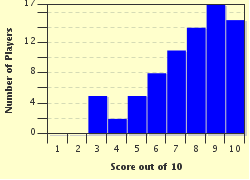Quiz Answer Key and Fun Facts
1. The 100 metres dash is the first event on day one of the decathlon. On which part of the track is it run?
2. The second event on day one of the decathlon is the long jump. What did the athletes in this original sport have to once carry in each hand while jumping?
3. The third event on day one of the decathlon is the shot put. Part of the modern Olympics since 1896, the origins of this sport date back to which period of history?
4. The fourth event on day one of the decathlon is the high jump. Various methods of jumping the bar once included which of the following?
5. The 400 metres sprint is the last event on day one of the decathlon. What is notable about this distance?
6. First event on day two of the decathlon is the 110 metres hurdles. Until 1935, how were records recognised?
7. The second event on day two of the decathlon is the hammer throw?
8. The third event on day two of the decathlon is the thrilling pole vault. For which very prosaic reason did pole vaulting originate?
9. The fourth event on day two of the decathlon is the javelin throw. Are non-orthodox throws permitted in this sport?
10. The last event in the champion of champions decathlon is a run over what distance?
Source: Author
Creedy
This quiz was reviewed by FunTrivia editor
1nn1 before going online.
Any errors found in FunTrivia content are routinely corrected through our feedback system.

